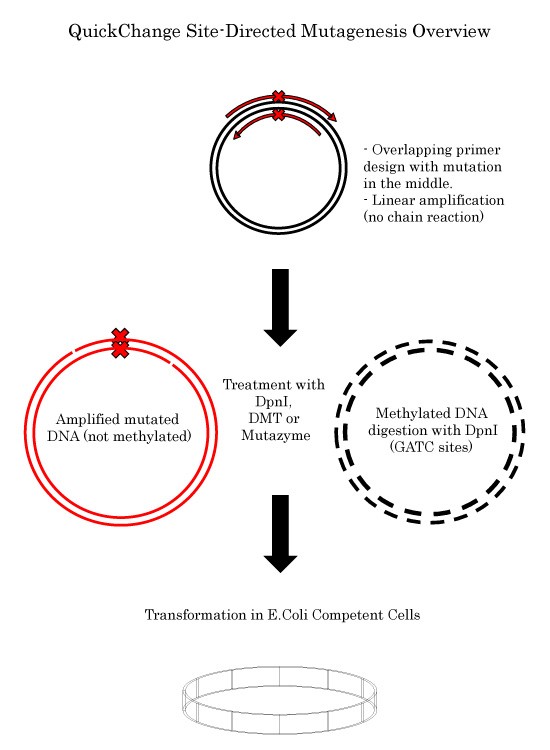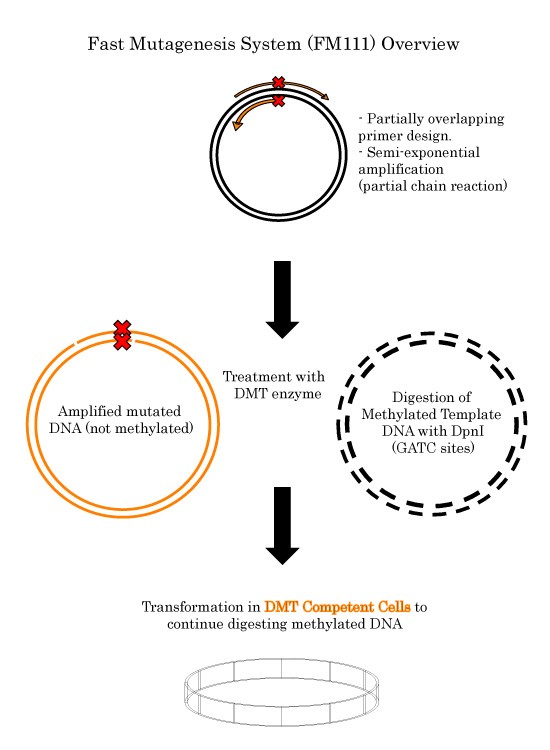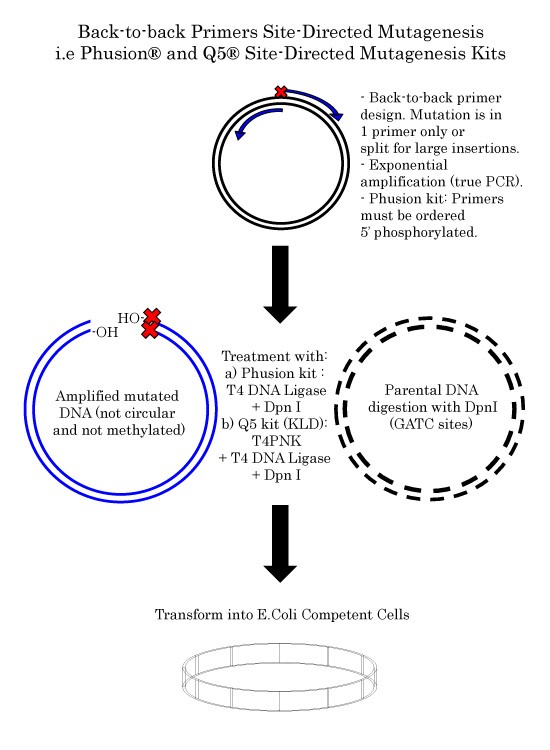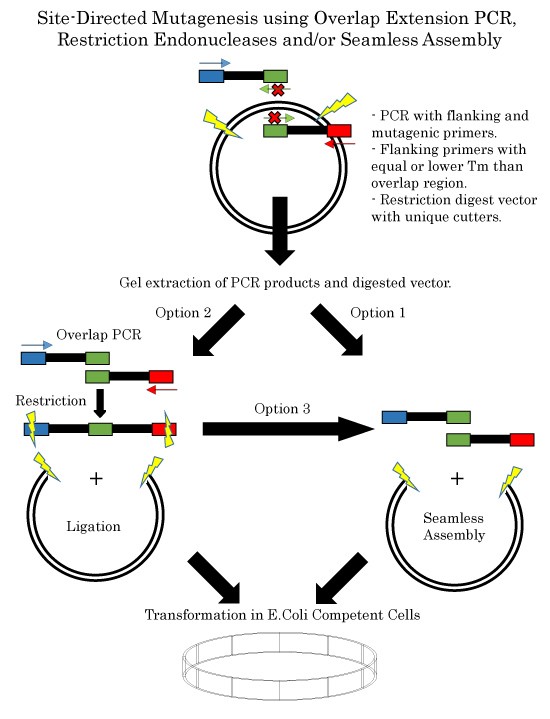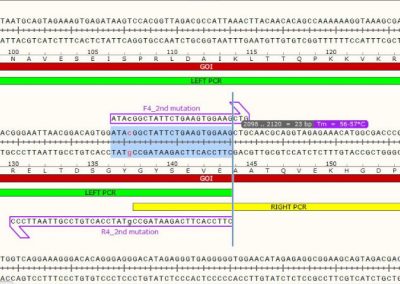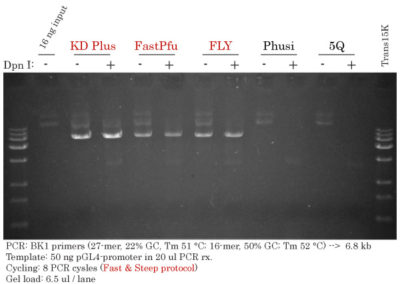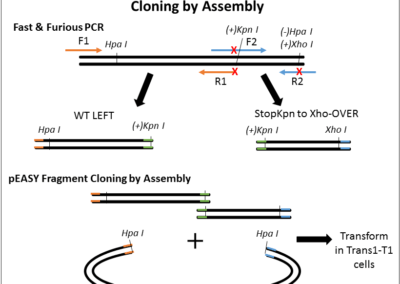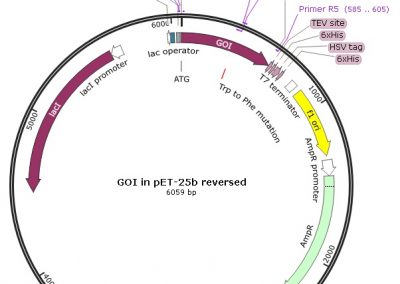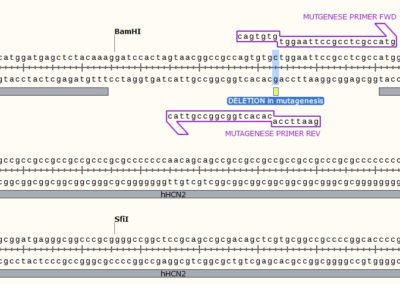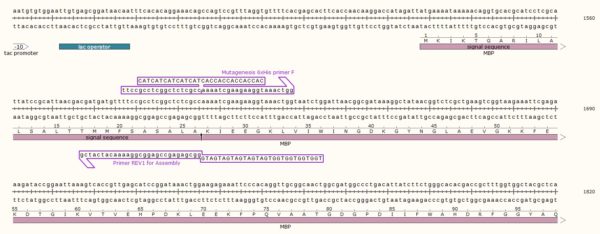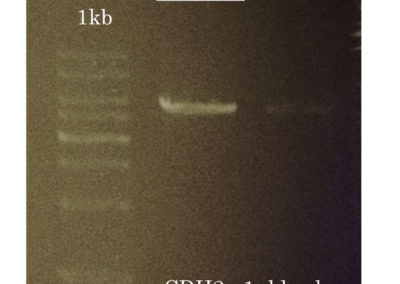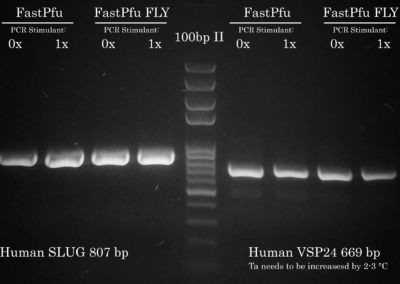Site-Directed Mutagenesis
Strategies, Protocols and Services available from Civic Bioscience Go to ServicesGo to ProtocolsSite-Directed Mutagenesis Strategies using Whole Vector Amplification (WVA)
QuickChange Site-Directed Mutagenesis
Advantages
- Both primers contain the mutation.
- In vitro removal of methylated DNA (parental template).
- Simple 3-step workflow***.
Disadvantages
- Long amplification protocol – 25 cycles (between 4 and 8 hours).
- Low yield amplification of DNA.
- Complementary primers anneal together.
- Tandem primer insertion at or near the mutated site often occurs.
- Large insertions are problematic.
- Large deletions are problematic.
***To ensure that no extra mutations are introduced in the vector backbone, site-directed mutagenesis strategies that use whole vector amplification require subcloning of the sequenced insert into a vector that hasn’t been amplified by PCR. Alternatively, the whole vector can be sequenced.
TransBionovo's Fast Mutagenesis System
Advantages
- Semi-exponential amplification PCR.
- Both primers contain the mutation.
- In vitro digestion and in vivo degradation of non-mutated parental DNA.
- 95% of clones contain the desired mutation.
- Suitable for insertions of ∼ 45 bases.
- Suitable for large deletions.
- Easy 3-step workflow***.
Disadvantages
- Long PCR protocol – 25 cycles (between 4 and 8 hours).
- Partially complementary primers may anneal together.
- Tandem primer insertion at or near the mutated site may occur.
- Large deletions may be challenging because of the partial overlap between primers.
***To ensure that no extra mutations are introduced in the vector backbone, site-directed mutagenesis strategies that use whole vector amplification require subcloning of the sequenced insert into a vector that hasn’t been amplified by PCR. Alternatively, the whole vector can be sequenced.
KLD Site-Directed Mutagenesis using Back-to-Back Primer Design
Advantages
- High yield exponential PCR.
- Simple primer design.
- In vitro digestion of the template DNA.
- 90% of clones contain the desired mutation.
- Suitable for insertions of ∼ 80 bases or longer if using oligos > 60-mers.
- Ideal for creating large deletions.
- Easy 3-step workflow***.
Disadvantages
- Long PCR protocol – 25 cycles (between 4 and 8 hours or 1 to 2 hours using Fast & Steep PCR).
- Only 1 primer contains the mutation which may generate non-methylated and non-mutated PCR products.
- Primers or Dpn I-generated fragments are likely to be inserted at the ligation site.
***To ensure that no extra mutations are introduced in the vector backbone, site-directed mutagenesis strategies that use whole vector amplification require subcloning of the sequenced insert into a vector that hasn’t been amplified by PCR. Alternatively, the whole vector can be sequenced.
Multisite Mutagenesis using Seamless Cloning and Assembly
Advantages
- High yield exponential PCR***.
- Versatile technique.
- In vitro digestion of the template DNA (optional).
- 90% of clones contain the desired mutation and will be intact.
- Suitable for large insertions.
- Suitable for large deletions.
- Ideal for creating multiple mutations.
- 4-step workflow (gel extraction of PCR amplicons is recommended)
Disadvantages
- Multiple primers to order (minimum of 4 primers for creating 1 mutation when performing whole vector amplification)
- Multiple PCR reactions to perform.
***To ensure that no extra mutations are introduced in the vector backbone, site-directed mutagenesis strategies that use whole vector amplification requires subcloning of the sequenced insert into a vector that hasn’t been amplified by PCR. Alternatively, the whole vector can be sequenced.
Site-Directed Mutagenesis Strategies using Cloning by Ligation or Seamless Assembly
Two-Sided PCR Overlap Extension followed by Cloning
Clear benefit :
Cleanest way to perform site-directed mutagenesis without altering the backbone vector.
Advantages
- Both primers at the mutation site contain the desired mutation.
- Short and easy PCR reactions.
- In vitro removal of methylated template DNA may be performed (proceed with caution by verifying restriction sites first)
- Suitable for large insertions
- Suitable for large deletions
- Ideal for introducing multiple mutations (close or distant).
- No subsequent subcloning required and no need to sequence the whole vector.
Disadvantages
- Multiple primers to order (minimum of 4 primers for creating 1 mutation).
- Multiple PCR reactions to perform.
- Gel extraction and/or PCR purification required.
- Multiple steps to perform, but the vector backbone remains intact through the entire process.
Fast & Clean Site-Directed Mutagenesis
The Fast & Clean Site-Directed Mutagenesis Protocol uses a combination of techniques to achieve unprecedented precision, efficiency and clean site-directed mutagenesis.
- Fast & Steep PCR
- Seamless DNA Assembly Site-Directed Mutagenesis
- 2SPO extension (optional)
Clear benefit :
- Cleanest way to perform site-directed mutagenesis without altering the backbone vector.
- Huge Huge Huge time-saver
Advantages
- Reduces the number of PCR cycles to a minimum (5-10) (total average run time is 25 min);
- Enables to perform large insertions;
- Enables to perform large deletions;
- Reduces the time normally required to perform site-directed mutagenesis using two-sided PCRs and/or overlap extension PCR;
- Enables at least 3 alternative solutions in case of failure (using the same ssDNA primers);
- Offers a clean alternative to whole vector amplification techniques that require subsequent subcloning steps or sequencing of the entire plasmid. No sublcloning is required.
Disadvantages
- Multiple primers to order (minimum of 4 primers for creating 1 mutation instead of 2).
- Multiple PCR reactions to perform (but they are completed 4-times faster).
- Gel extraction and/or PCR purification steps required for all purification steps.
About The Fast & Steep PCR Protocol
Advantages of the Fast & Steep PCR Protocol
Very Fast : 15-45 min for 300 bp and 10 kb respectively.
- PCR cycling time varies depending on template lenght and ramping rates
Efficient : incorporates up to 100% of primers in a very short amount of time.
- GC content and primer specificity may affect the efficiency.
Non-Ambiguious results : PCR amplicons have fully incorporated your primers.
- When performing site-directed mutagenesis, so far, our success rate is 100%.
Low error rate / High-Fidelity : 5 to 10 PCR cycles is sufficient.
- Limits the chances of introducing errors by up to 2E15 -fold (10 vs 25 PCR cycles).
PCR Services
CivicBio PCR optimization, Cloning & Site-Directed Mutagenesis Services

Glycerol Stocks
En utilisant votre service de clonage et de mutagénèse, je peux me concentrer les les expériences qui sont vraiment importantes pour le laboratoire afin d’accélérer la vitesse de nos publications. En plus, le travail est garanti.
Si j’ai à cloner ou faire de la mutagénèse, simplement le coût d’acheter 2 enzymes et des bactéries coûte plus cher et le travail n’est toujours pas fait. Je préfère largement utiliser un service de clonage et avancer dans mes expériences durant ce temps.

